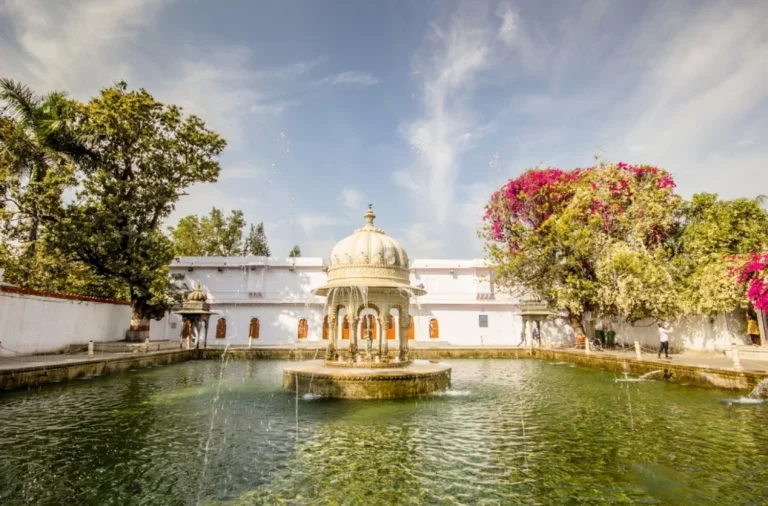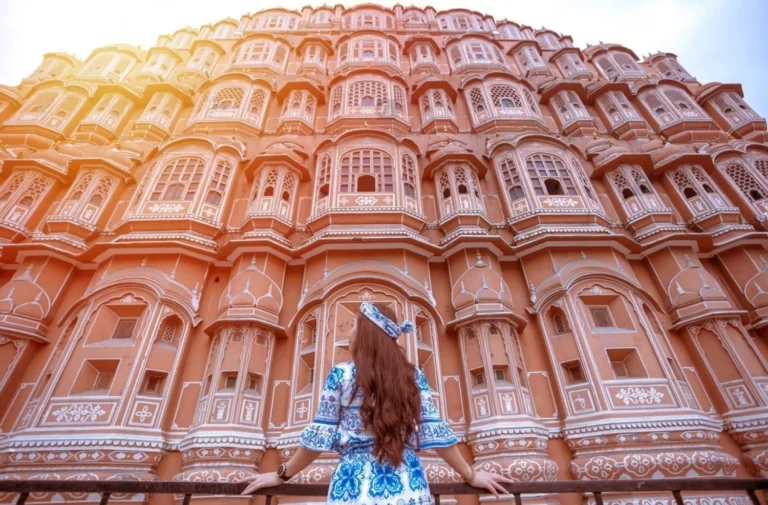The Taj Mahal is synonymous with Agra! However, there is a “world” beyond this spectacular structure that gives Agra’s sightseeing activities a tremendous boost. The following list of attractions in and around Agra will help you have a genuinely memorable trip.
These include numerous structures from the Mughal era, forts, and monuments, all of which are located in Agra and its surrounding suburbs. Along with the towns of Delhi and Jaipur, Agra makes up the Golden Triangle and is known for its strong love of the past mixed with a touch of modernity.
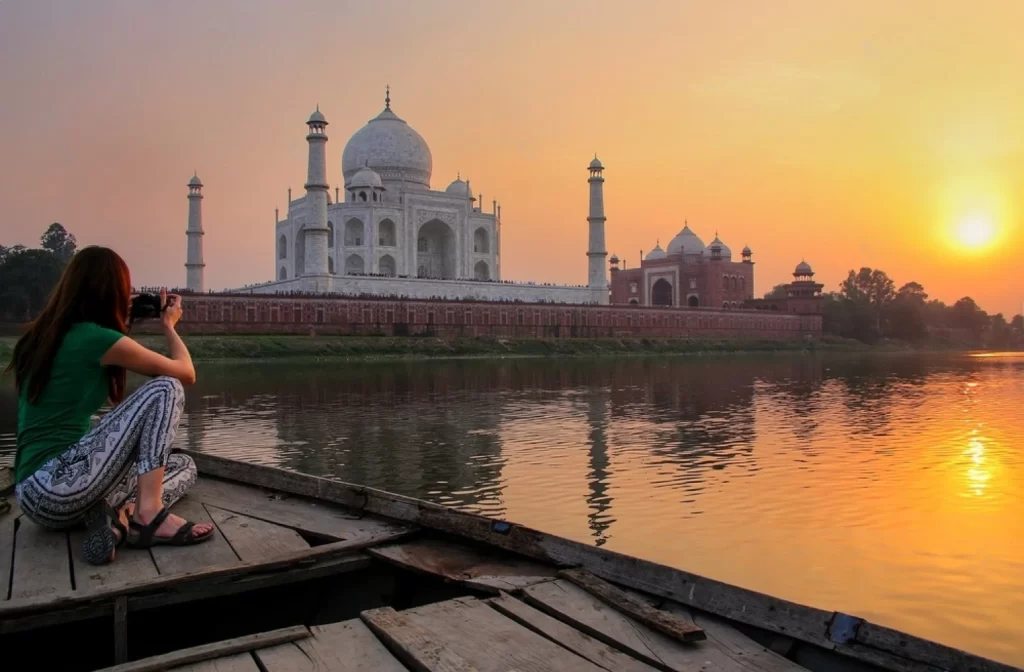
Best places to visit in Agra
In Agra, there are many attractions to explore. During his reign, Emperor Shah Jahan built many of the city’s treasures that still draw a lot of tourists today. Learn fascinating historical details about Agra and Fatehpur Sikri while admiring the magnificent Mughal architecture. Here is a list of the Agra tourist sites you really must check out while visiting this lovely city.
- Taj Mahal
- Agra Red Fort
- Fatehpur Sikri
- Jama Masjid
- Moti Masjid
- Sikandra Fort
- Itmad-Ud-Daulah’s Tomb
- Jodha Bai Ka Rauza
- Mehtab Bagh
- Traditional Bazaars
- Chini Ka Rauza
- Akbar’s Tomb
- Anguri Bagh
- Machhi Bhawan
- Diwan-I-Aam
- Khas Mahal
- Diwan-I-Khas
- Nagina Masjid
- Mariam-Uz-Zamani Tomb
- Radha Soami Samadhi
Taj Mahal
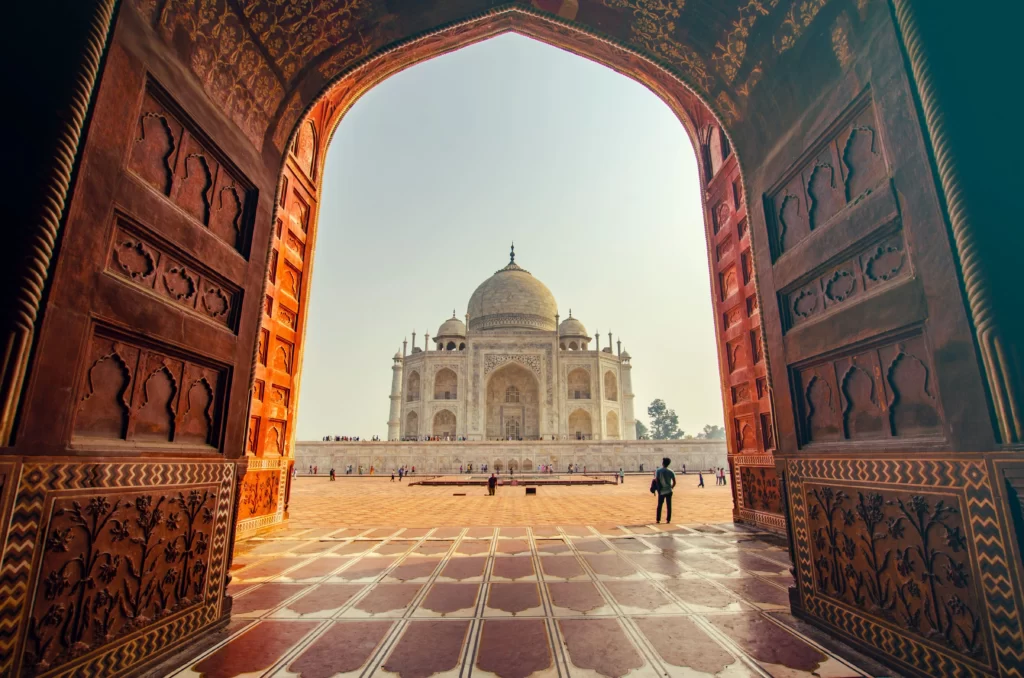
Here we are, then! Finally, we reach the Taj Mahal, one of the must-see attractions in Agra. In actuality, the Taj Mahal is the primary draw of the majority of tours.
It was constructed on Shah Jahan’s orders as a tribute to his love for his cherished wife Arjumand Bano Begum and is one of the Seven Wonders of the World and a magnificent example of Mughal architecture.
The Taj Mahal’s exterior and interior architecture are both magnificently crafted from white marble. The inside chamber is shaped like an octagon and is covered in priceless diamonds.
The external gardens, awash in greenery and fresh air, match their opulence. The Taj Mahal is one of the most beautiful historical sites since it exudes tremendous Mughal elegance.
Agra Red Fort
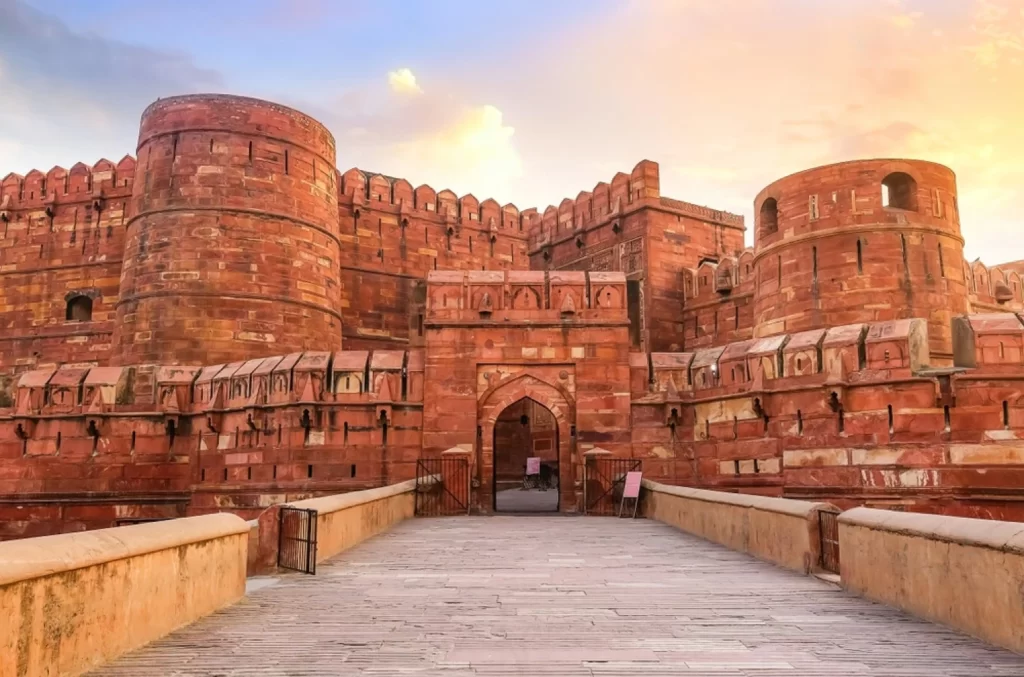
The Agra Red Fort, a UNESCO World Heritage Site, serves as a magnificent memorial to the height of the former Mughal Empire. This massive fort, which covers an area of 3,80,000 square metres, was constructed in 1556 by Emperor Akbar and afterwards restored in 1573 using red sandstone.
The fort, which is 2.2 kilometres from Agra, is a complete fortification and is surrounded by 70-foot-high compound walls. One of the most important things to do in Agra is to visit the Agra Fort.
The Agra Fort, also known as the Walled City, has four gates on its four sides, the most well-known of which are the Delhi Gate and the Lahore Gate.
The Shish Mahal and Khaas Mahal are two of the several palaces present in this fort.
Other noteworthy locations in this fort include the reception areas, Diwan-i-Khas and Diwan-i-Aam, to a number of old Masjids, including Moti Masjid and Nagina Masjid.
Fatehpur Sikri
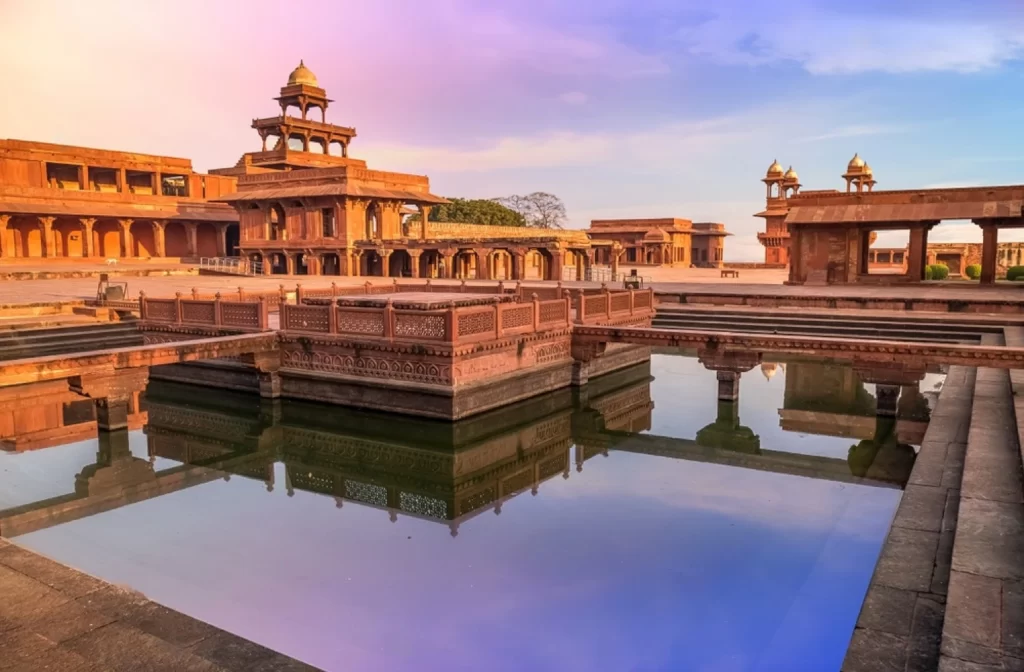
One of the must-see Agra locations is Fatehpur Sikri. It was once the capital city of numerous Mughal Emperors, including Akbar.
Located in the Agra area, it is a mediaeval town. Prior to becoming the capital, Sikri was a decrepit village. The current name was given to it in honour of Emperor Akbar’s conquest of Gujarat in 1573.
The town of Fatehpur Sikri, which is 3 km long and 1 km wide, is built in the Persian, Indian, and Islamic architectural styles. The village was built using red sandstone that was quarried nearby.
The town’s 6-kilometer perimeter wall is surrounded by seven gates.
UNESCO named this town to its list of World Heritage Sites. It is considered one of the top tourist attractions in Agra and should be on everyone’s agenda.
Jama Masjid
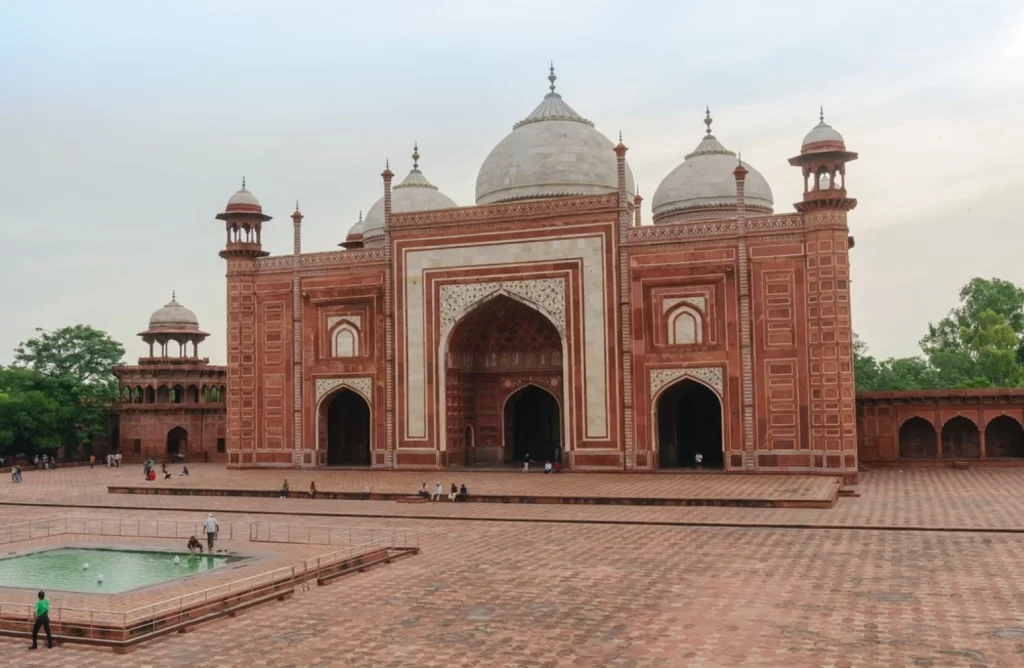
Agra’s Jama Masjid must be included on every list of noteworthy locations to visit. Despite being a religious landmark, it is renowned for its incredible loftiness and architectural richness, which captivates people of all backgrounds.
There are three entrances to this Masjid, which has four minarets and can comfortably hold up to 25,000 people for prayer at once. On the eastern side of Jama Masjid lies Agra Red Fort. Both structures have a beautiful appearance.
The magnificent redstone tapestry, massive archways, and tall dome give this area a certain air. This World Heritage monument is a must-see attraction in the area and features golden script on a royal blue background.
The “Friday Mosque” is the common name for this mosque from the 17th century.
Moti Masjid
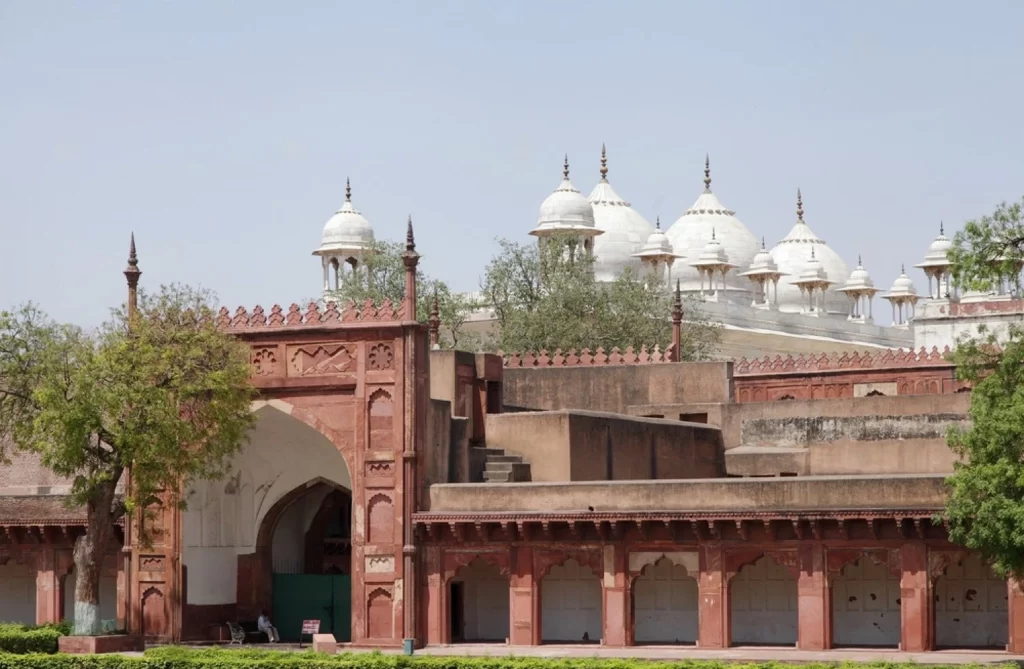
Speaking about masjids, the Moti Masjid is another that is among the top tourist attractions in Agra. One such architecturally significant structure that must not be ignored is the well-known Moti Masjid.
Due to its pristine white facade that gleams like a pearl in the sunlight, Moti Masjid, which was built by Mughal King Shah Jahan, is also known as the Pearl Masjid. It was created by the emperor specifically for the Royal Court members.
The Moti Masjid’s interiors are decorated in a stunning white colour scheme. The focal point of the courtyard is a white marble tank. The marble pillared sundial serves as evidence of the architectural
Sikandra Fort
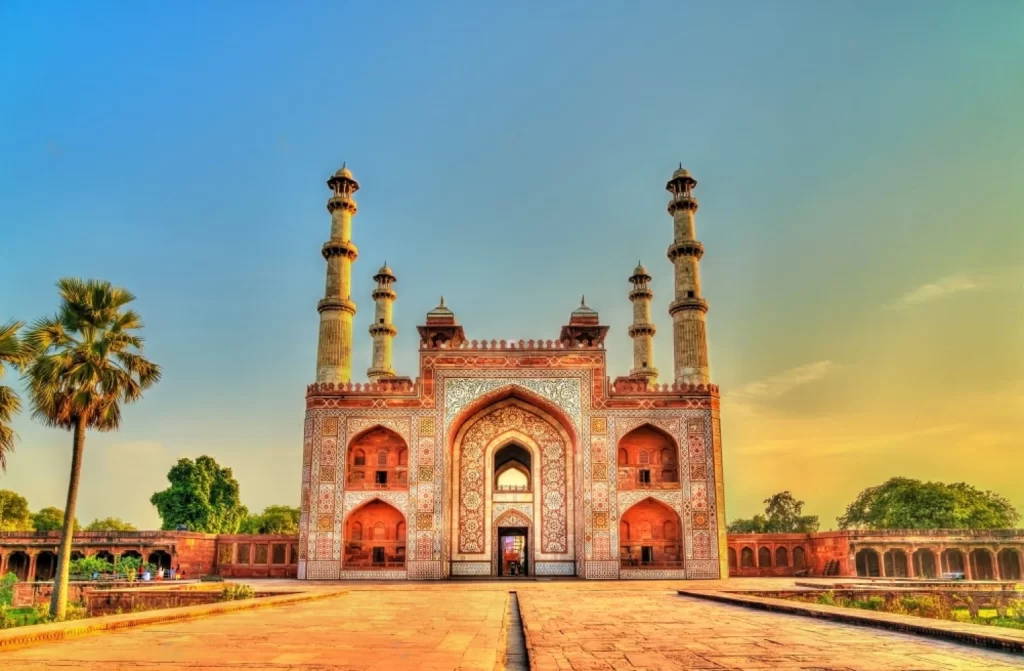
One of the most significant historical sites and a must-see destination in Agra is Sikandra Fort. This richly coloured sandstone building stands out for its ageless architectural beauty and ability to convey the region’s magnificent past. Akbar’s tomb is housed within the fort, which is situated in a location named Sikandra. This imposing fort is surrounded by verdant gardens on all sides and is protected by high walls.
According to current landscaping customs, the garden is separated into four more manageable sections. A number of fountains enhance the structure’s charm. Sikandra Fort, which is said to have been personally overseen by Emperor Akbar, has five floors and is decorated with beautiful sculptures. Unquestionably, this well-preserved monument is among the top attractions in Agra that visitors shouldn’t miss.
Itmad-Ud-Daulah’s Tomb
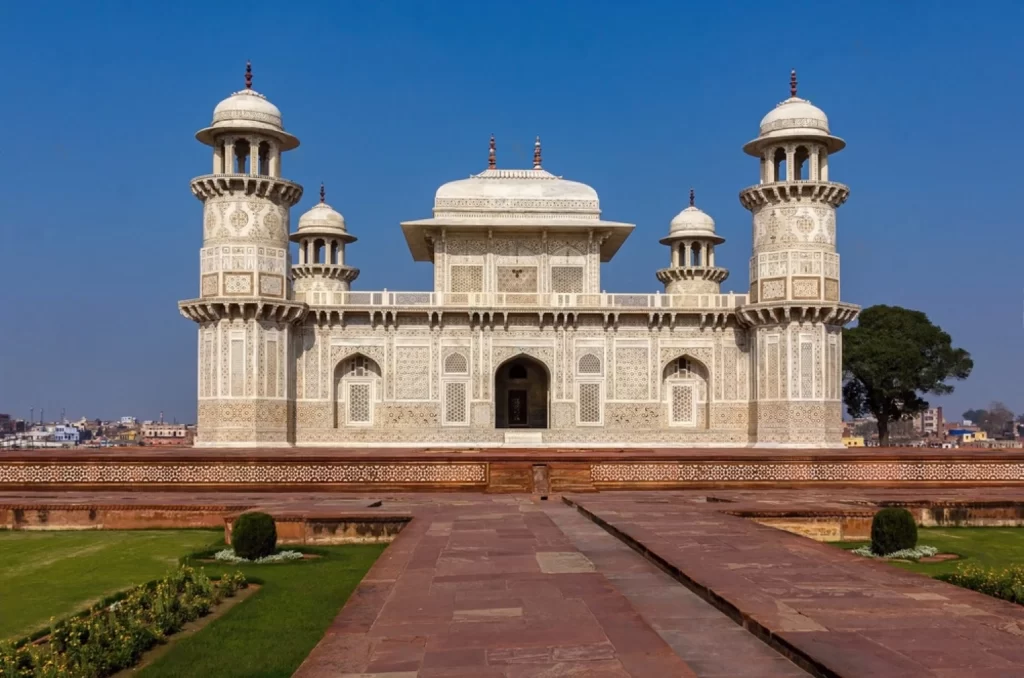
The tomb of Itmad-ud-Daulah is Agra’s second most famous architectural masterpiece after the Taj Mahal. Its intricate carvings and beautiful inlays are fascinating to observe.
It is known as the “Baccha Taj,” a scaled-down counterpart of the Taj, and is regarded as the first draught of the Taj Mahal. One of the must-see locations in Agra close to the Taj Mahal is this red sandstone tomb, which shouldn’t be skipped from the agenda.
This immaculate white mausoleum, which is situated on the Yamuna River’s banks, is an ideal representation of Islamic architecture and design.
You must see it to believe it when it comes to the ornately sculpted arches, flawless minarets, elaborate inlay work, stunning floral artwork, and creative use of marble to highlight the grandeur of the building.
Jodha Bai Ka Rauza
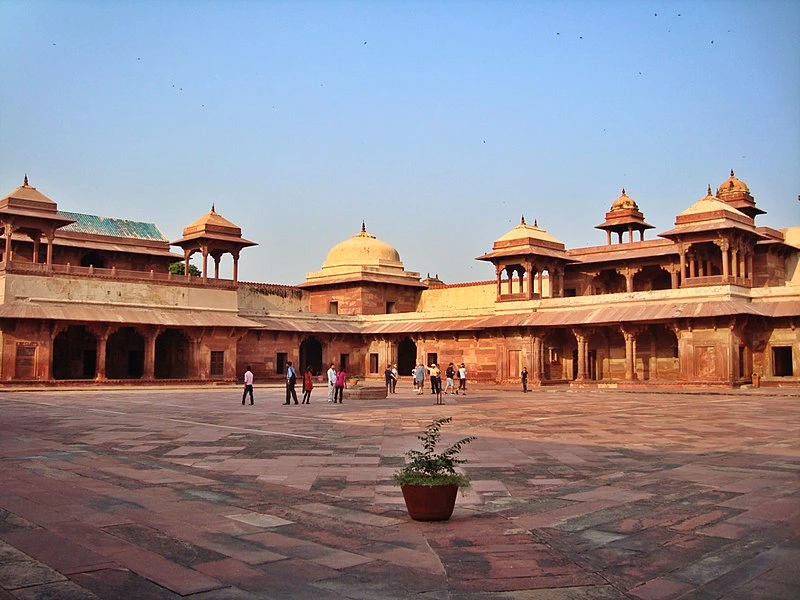
It was the residence of the first Rajput consort of Emperor Akbar and was also known as Jodha Bai’s Palace.
The palace of Jodha Bai, a straightforward yet elegant building, lies next to the Jahangiri Mahal.
The building is a notable example of Indo-Mughal architecture and contains many little but significant architectural details from Gujarat and Gwalior.
The Rauza, or Palace, is located 6 kilometres from the Agra Fort. There are small openings in the palace’s interior that provide views of the Taj Mahal.
This palace, which is located in the Fatehpur Sikri region, serves as a living illustration of Mughal Emperor Akbar’s religious tolerance. The abundance of mural patterns featuring peacocks, lotuses, elephants, and other animals is a sign of the harmony between the two religions.
Mehtab Bagh
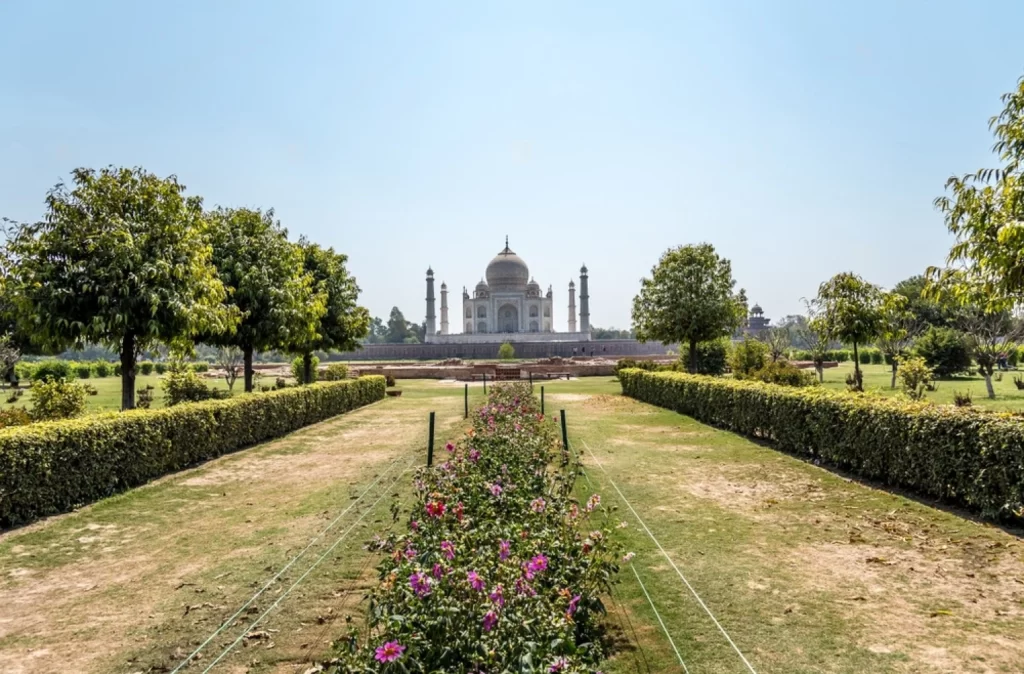
Mehtab Bagh is a square-shaped garden complex on the banks of the River Yamuna, situated to the north of the Taj Mahal and Agra Fort complex.
On the other side of the Yamuna River, the Taj Mahal is in perfect harmony with it. It is a well-liked location for photographers to get a beautiful sunset view. Travellers continue to flock to it all year long since it is one of the best sites in Agra to visit in the evening.
In this breathtaking garden, an octagonal tank is surrounded by four towers, one at each corner. On full moon evenings, the Taj Mahal’s reflection in the tank is a sight to behold.
Along with fruit-bearing trees, the garden is abundant with flowering plants that bloom and medicinal herbs. With its four gardens laid out, it is the ideal representation of Mughal architecture. The substantial water tank to the east of the building makes sure that the entire region is appropriately watered.
Traditional Bazaars

Shopping at one of the many city’s shopping districts is a necessary part of every tour of Agra. There is a wide range of unique artefacts, extinct handicrafts, and souvenirs can be found in the traditional bazaars.
The marble Taj Mahal replica that is currently in high demand is particularly significant.
Subhash Bazaar, Kinari Bazaar, Raja ki Mandi, and Sadar Bazaar are just a few of the city’s major bazaars.
Sadar Bazaar stands out among these. One of the best spots to visit in Agra after dark is here.
Tourists are particularly drawn to the dazzling variety of leather goods, crafts, and clothing. In Agra, you might also sample the local cuisine.
Chini Ka Rauza
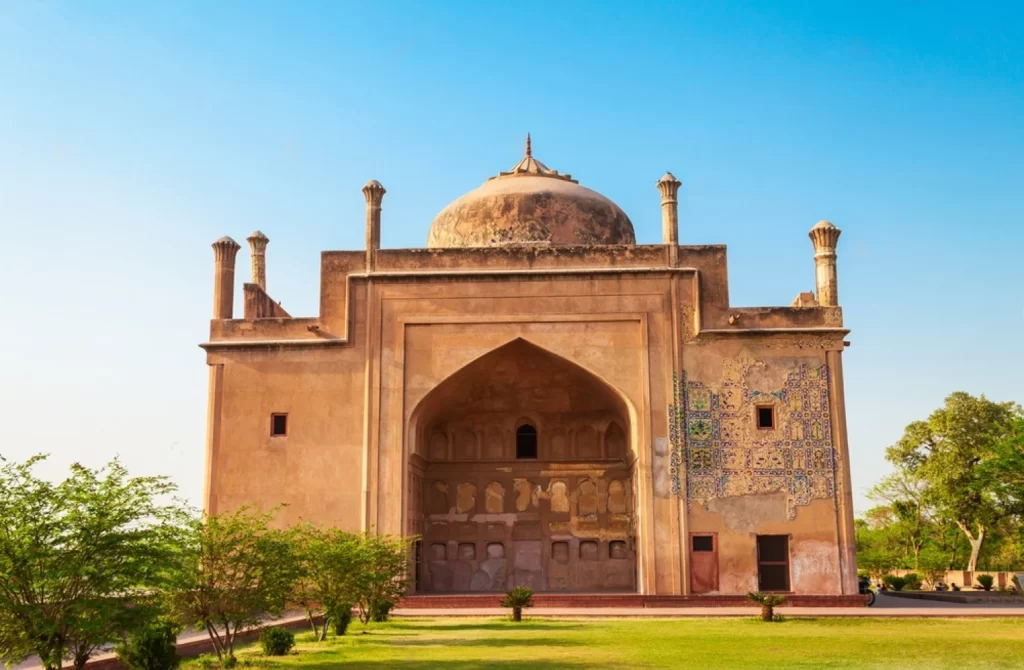
If you’re visiting Itimad-ud-Daulah Tomb in Agra, you should also visit Chini ka Rauza.
The mausoleum is in honour of Allama Afzal Khan Mullah, a well-known Persian philosopher and poet who lived during the reign of Jahangir. Later, he was elevated to wazir.
The mausoleum, which was constructed in 1635 AD, is an illustration of Indo-Persian design.
The structure’s core chamber is octagonal in shape, and it is tiled throughout. The tomb is situated in a lovely area with a view of the Yamuna River.
Akbar’s Tomb
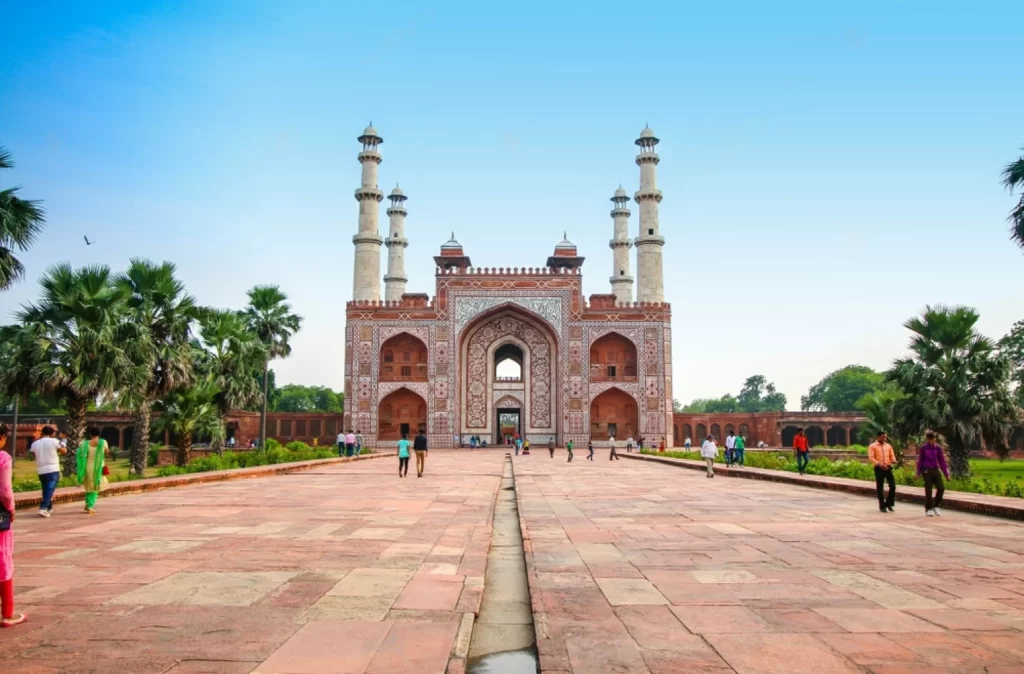
Akbar’s Tomb, which was constructed between 1605 and 1613, is where the emperor’s everlasting remains are replaced.
The tomb was built in Sikandra by Akbar himself when he was still alive. When Aurangzeb came to power, his army stole everything from the tomb, including gold, silver, and jewels.
Yet it continues to be one of Agra’s most stunning tourist destinations. It may be accessed by the southern doorway, which opens out to a vast garden set up in Charbagh style.
Anguri Bagh
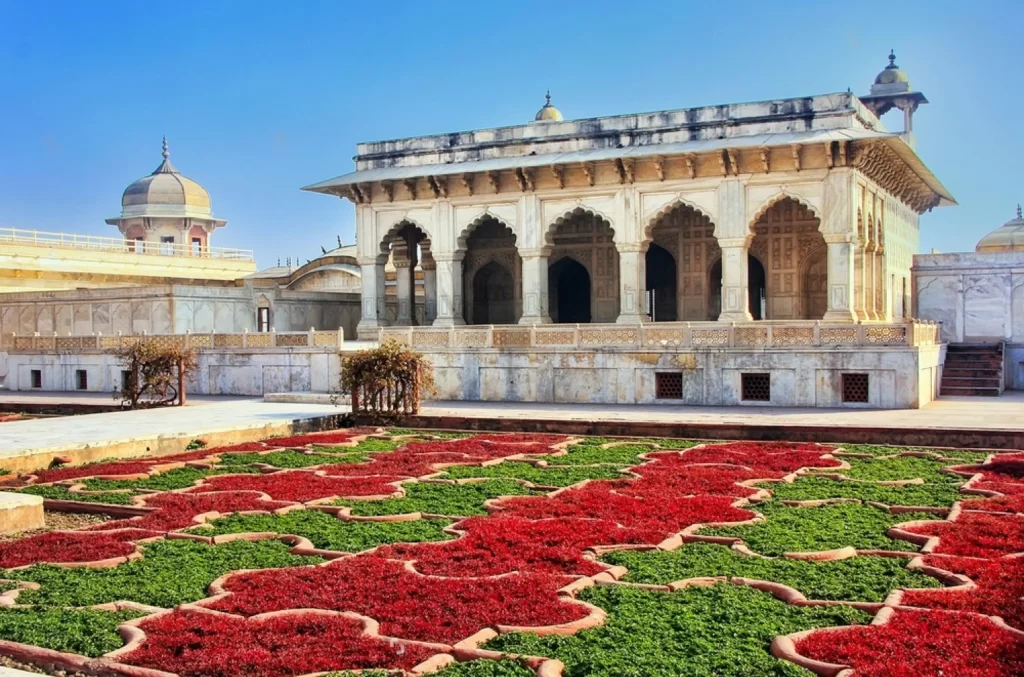
On the grounds of the Agra Fort, there is a popular tourist attraction called Anguri Bagh. Shah Jahan could enjoy evening strolls because to the opulent gardens, which were built in 1637.
The garden was built in the Charbagh style, which is distinguished by its four divisions and elaborate geometric designs. In ancient days, the garden produced the juiciest grapes, which were used to make wine for the emperor. He certainly has good taste.
Machhi Bhawan

A magnificent landscape surrounds the two-story structure Macchi Bhawan, which is distinguished by its arched halls. Due to the marble fountains and pools that were decorated with gold and silver fish, it was given the name “machi Bhavan.”
Shah Jahan’s golden throne, which gave him a 360-degree view of the court, once stood in this location. It is one of the top attractions in Agra and is situated in the Agra Fort across from the Diwan-i-Aam.
Diwan-I-Aam
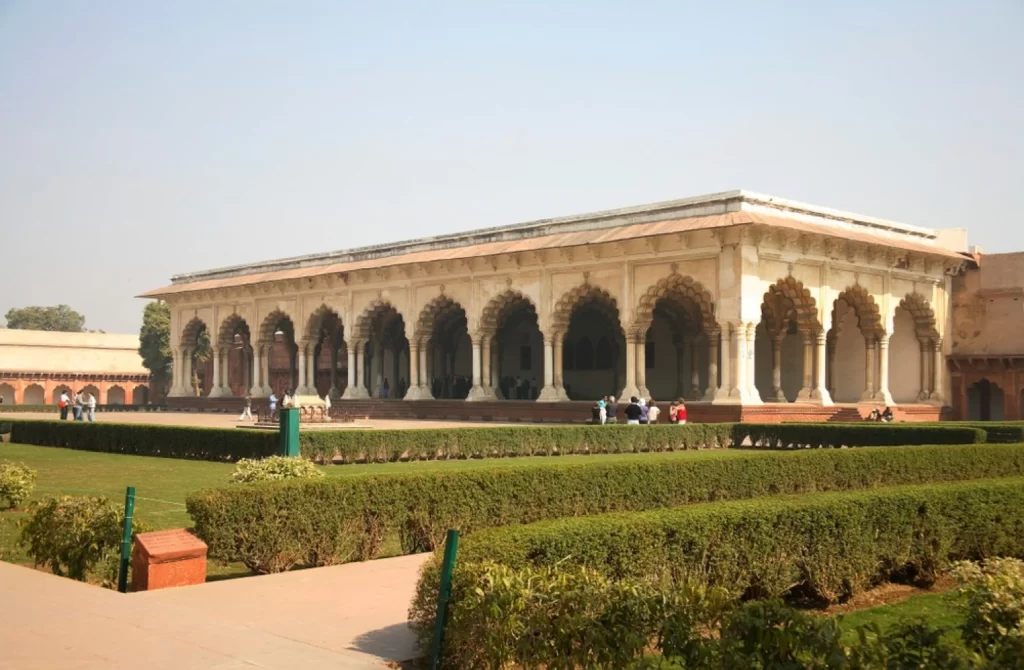
Diwan-i-Aam, as its name suggests, used to be the location of public assemblies and general meetings.
Shah Jahan used to hear the grouses of the common people here. Three pieces make up the enormous hall, which was initially constructed out of red sandstone.
With the aid of a golden barrier in the front and silver railing on the other three sides, the emperor’s throne was isolated from the courtiers.
Jharokha Darshan was the name of the ceremony where the emperor spoke to the audience.
Khas Mahal

As the name implies, the emperor constructed the Khas Mahal for his daughters Roshnara and Jahanara.
The ceilings and niches on the walls are lavishly decorated. That explains why it took 9 years to construct this private palace.
On either side of the Khas Mahal, which is perched atop it, are the Yamuna River and Anguri Bagh. Explore the palace’s grounds and take in the stunning architecture and alluring scenery.
Diwan-I-Khas
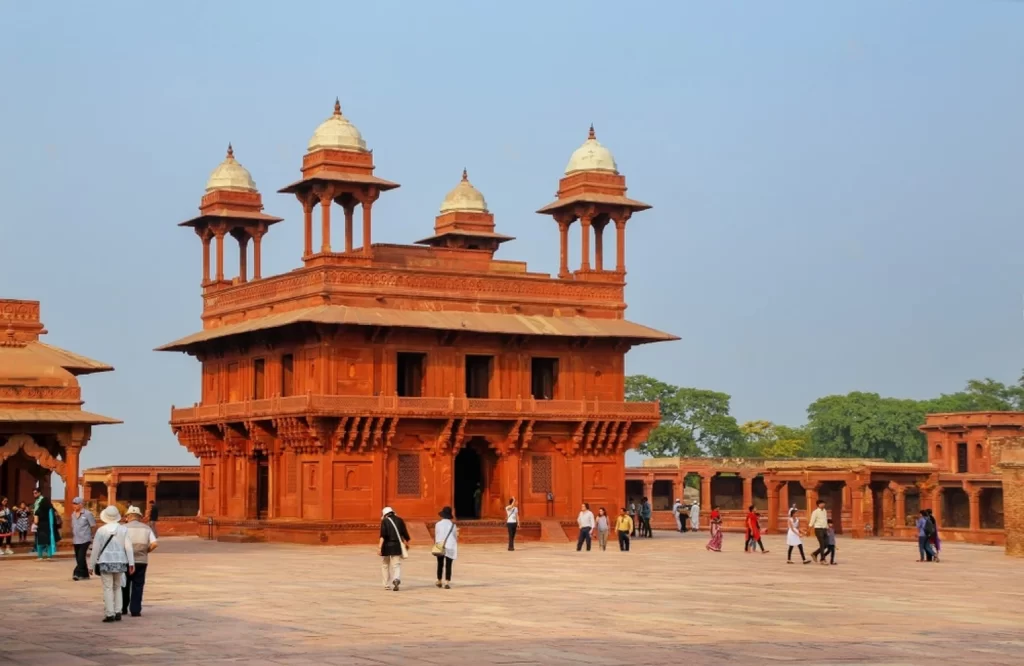
Shah Jahan interacted with distinguished visitors like kings, ambassadors, and nobles in a separate private area of the palace.
The iwan-i-Khas was the name of this location. It is located on Macchi Bhawan’s opposite side.
Before being relocated to Delhi’s Red Fort, the renowned Takht-i-Taus (Peacock Throne) was held here. Persian inscriptions have been inscribed inside the black walls of the hall.
Nagina Masjid
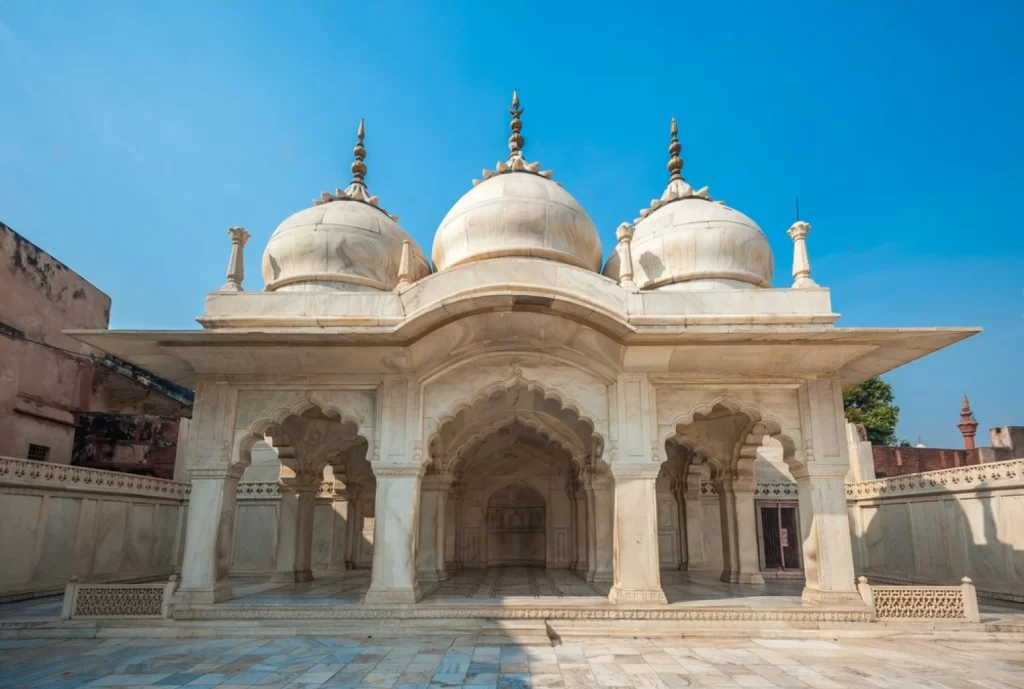
Shah Jahan constructed the Nagina Masjid, one of the most stunning sights in Agra, between 1631 and 1640 AD for the royal ladies.
White marble was used in the construction of the private mosque, which has beautiful architecture and tasteful decorating.
The mosque is distinguished by lovely domes and magnificent arches as well. On the western side of the private mosque is where the prayer room is situated.
Mariam-Uz-Zamani Tomb
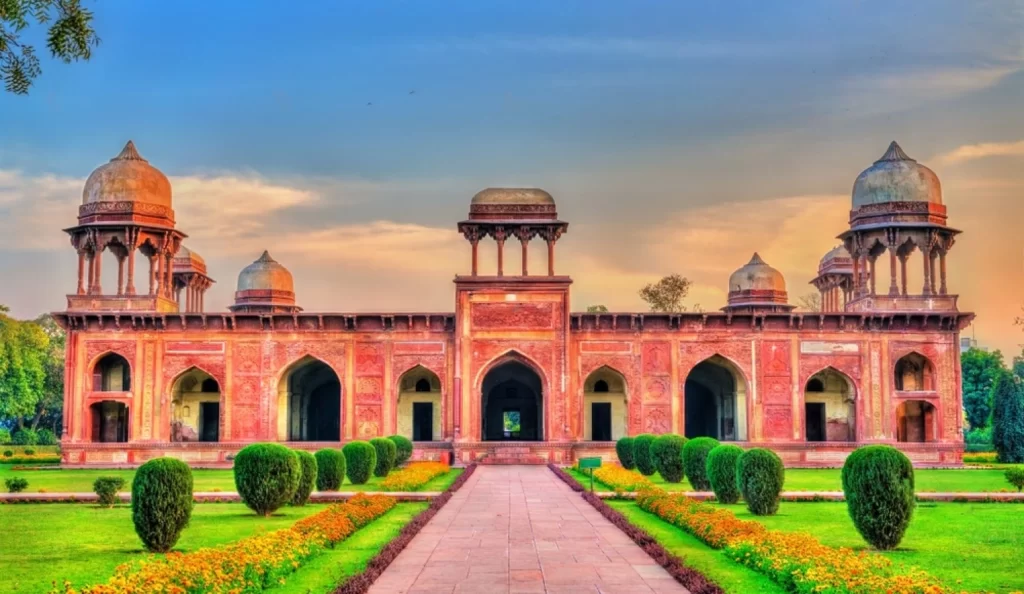
The mausoleum of Jodha Bai, Akbar’s Hindu wife, is located in Mariam-uz-Zamani, one of the most visited tourist attractions in Agra.
She has been known by several names throughout history, Mariam-uz-Zamani being one of them.
On the west side of Akbar’s Tomb is the tomb. Jahangir erected the mausoleum in honour of his devoted mother. Red sandstone was used to build the mausoleum, which is encircled by opulent Mughal gardens. It is among the most breathtaking locations in Agra.

